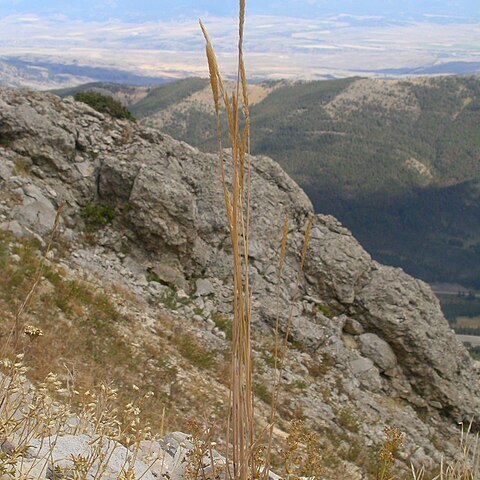Perennial, densely tufted. Culms erect, 3–60 cm tall, 1–2 mm in diam., pubescent to tomentose especially below panicle, 1–3-noded. Leaf sheaths pubescent; leaf blades flat or rolled, 2–15 cm, 2–4 mm wide, densely to sparsely hairy on both surfaces or only abaxial surface, or glabrous, margins often setose; ligule 1–2 mm. Panicle spikelike, dense, linear to ovate or oblong in outline, lower part sometimes interrupted, 1.5–11 cm; branches short, appressed, pubescent to tomentose. Spikelets 4–9 mm, florets 2(or 3); rachilla hairs 1–1.5 mm; glumes subequal or slightly unequal, lower glume 4–8 mm, upper glume 5–9 mm, apex acuminate, occasionally briefly aristulate; lemmas lanceolate, 4–7 mm, scaberulous to pubescent, awned from upper 1/4–1/3, apex usually 2-denticulate, teeth often mucronate, occasionally subentire; awn 2–7 mm, weakly geniculate with loosely twisted column, or recurved at base, or almost straight; palea keels scaberulous. Anthers 0.7–1.3 mm. Fl. and fr. Jun–Sep.
Culms tufted, 1–5 dm, antrorsely hairy above, retrorsely so (or glabrous) below; sheaths retrorsely hairy; blades flat or involute, glabrous or hairy, 1–3 mm wide; infl 3–10 cm, dense, or interrupted at base, spikelets mostly 2-fld; first glume linear-oblong, 3–5 mm, 1-veined; second glume lanceolate to oblanceolate, 4–6 mm, 3-veined; hairs of the rachilla 0.5 mm; lemmas slightly surpassing the glumes, the terminal teeth 1.3–2 mm, narrowly triangular; awn flexuous, 3.5–5 mm; anthers 0.6–1.4 mm; 2n=14, 28, 42. Arctic and alpine meadows and shores; circumboreal, s. to the higher mts. of U.S., Hispaniola, Mex., and s. S. Amer.; in our range s. to N.Y., Pa., Mich., and Minn., and in N.C. The numerous proposed vars. are ill-defined and confluent.
A grass. It keeps growing from year to year. It forms tufts. It grows 8-50 cm high. It has hairs. The leaf blades are 4-10 cm long by 1-4 mm wide. The flowers panicle is oval and dense but can be interrupted.
For taxon occurring in Australia see Trisetum spicatum subsp. australiense Hultén ex Veldkamp.

